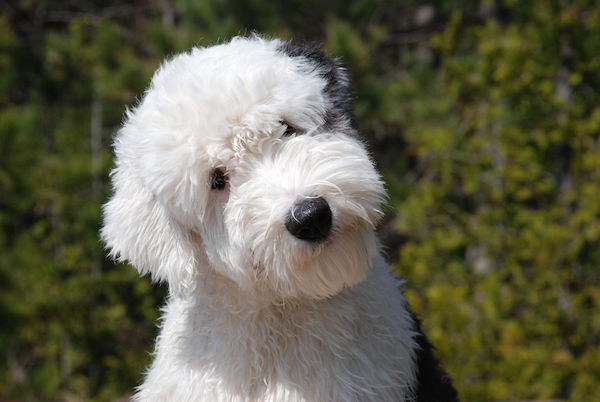
Whether it was falling in love with the breed through movies (The Shaggy Dog, The Shaggy DA, Chitty Chitty Bang Bang or Serpico), a comic strip (“Farley” from “For Better or for Worse”), books (“Please Don’t Eat the Daisies” and “Peter Pan”) or a commercial (one has been the mascot of the Dulux paint company since 1961), there are few people who don’t know the Old English Sheepdog.
And what’s not to love? The engaging “muppet” exterior is an overcoat worn by easygoing, fun-loving clown whose wicked sense of humor is legendary. To a bobtail, everyone is a long lost friend, and to an OES owner, their uncanny ability to provoke laughter is legendary. Nancy Shaffer Smith of the OESCA shares that when an Old English Sheepdog disobeys, s/he’ll stick their butt in the air as if to say, ‘Don’t be so serious!’” This isn’t to say the breed is a pushover. An OES is a formidable force when protecting its flock – people or sheep. Humor, devotion, and protectiveness made this a terrific breed.
Such qualities make it baffling, then, that the Old English Sheepdog finds itself on the Kennel Club’s list of native breeds at risk of becoming a vulnerable breed. In 2010, 507 Old English Sheepdogs were registered in England. A year later, that number dropped an alarming 23%. Registration numbers rose and dropped in subsequent years, but in its native land, the breed hasn’t regained the footing it had even eight years ago.
In the United States, the OES reached the apex of its popularity over the last eight-seven years when it was ranked by the AKC as the 21st most popular breed in 1975, a steady climb from 1931 when it was 47th. Fast forward to 2013, and that ranking dropped to 78th place. Last year, the number improved to 70th place. What this means in actual breed numbers is unknown since the AKC stopped publishing registration numbers several years ago, a pity as it could serve as a gauge for how a breed is actually faring.
A trend toward smaller dogs isn’t a satisfying explanation as to why the Old English Sheepdog isn’t more popular since the three most popular breeds right now are also largish breeds: The Labrador Retriever, German Shepherd Dog, and Golden Retriever (in that order). Grooming, then, becomes a logical suspect, and while spoof-videos like the one below (which appears on the OESCA) are fun, they also telegraph work for the person thinking about owning an Old English Sheepdog:
Shaving an Old English Sheepdog is usually advised against, but many owners opt to give their dogs a shorter haircut. We defer to OES owners on this and hope they can offer advice in the comments section on how to manage the coat of a bobtail that isn’t in a show ring.
Image of Old English Sheepdog puppy by User:Squigman – Own work, Public Domain, https://commons.wikimedia.org/w/index.php?curid=26629575

Although this post is 5 years old, I will respond to your request for a response about how I manage my OESs coat.
In order to keep the coat manageable, it needs to be maintained on a regular basis. This means brushing three or four times a week to remove tangles and keep mats away. Bathing as needed, which is usually about once a month. After bathing and drying a guard comb of about an inch can be used on the clippers. Shaving would be a last resort when the coat has become too matted to be able to untangle without causing discomfort to the pup. I have heard that shaving actually alters the hair follicle when done too close to the skin. The key here is prevention.
The cost to groom an OES this year varies from $125 to $300, so if that is not in the monthly budget, then they can be groomed at home. The cost of equipment is a bit daunting, but its a one time expenditure. There is a learning curve and time involved, but it’s well worth the time, effort, and cash outlay